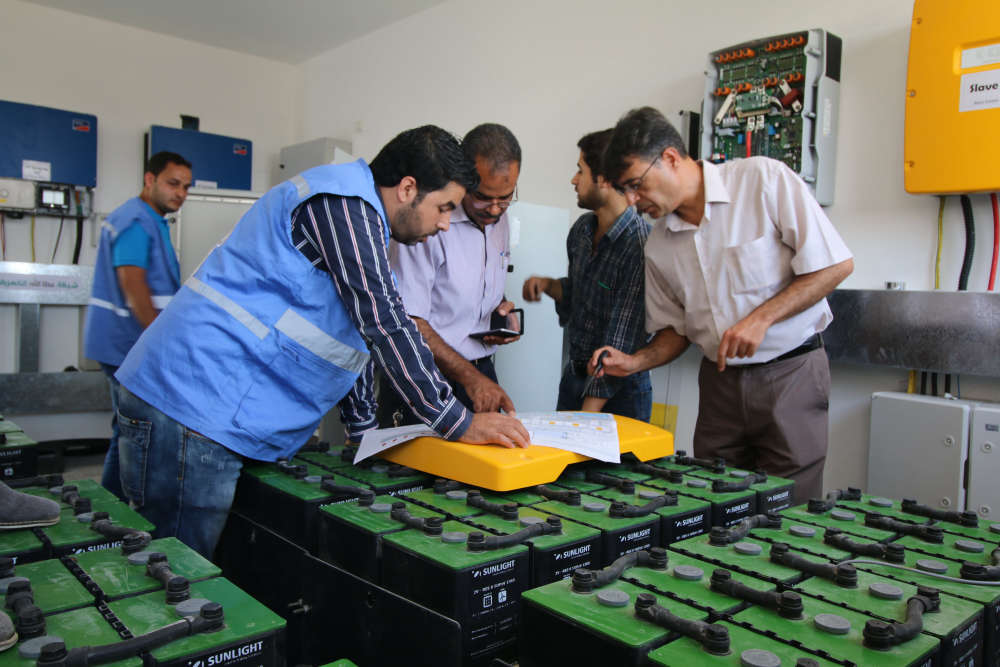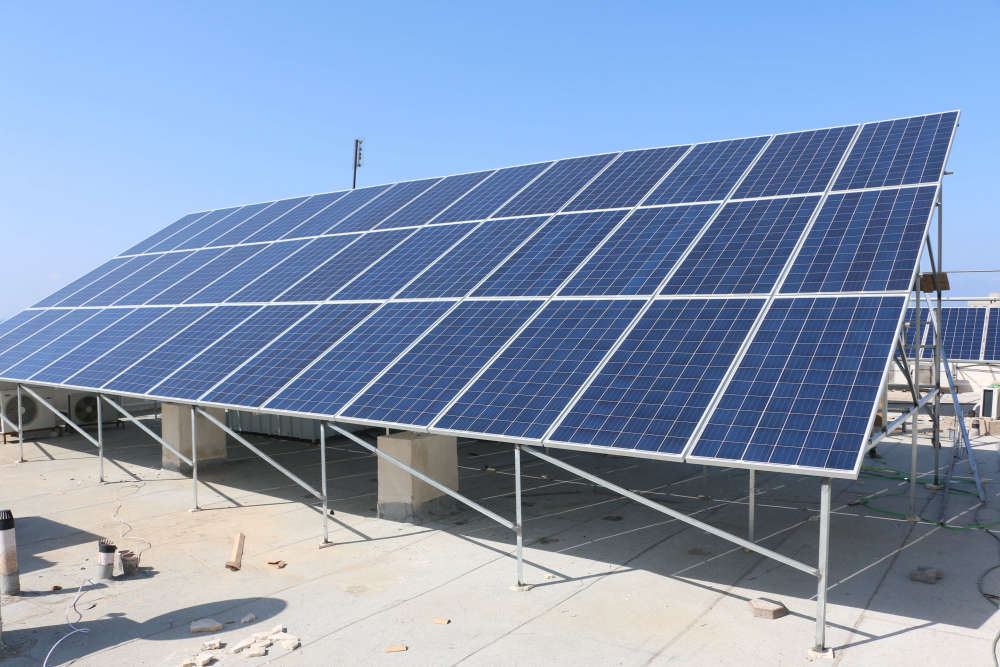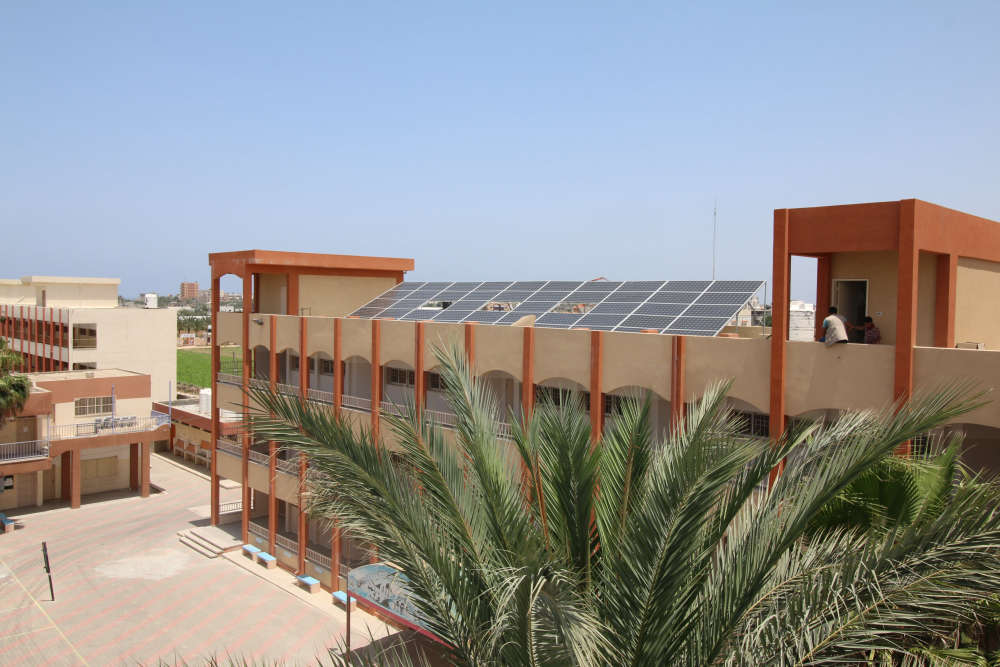By Hekmat El Khairy and
Mahmoud Abu Aisha
While the Sustainable Development Goals urge access to affordable, reliable, sustainable and modern energy for all, the Gaza Strip has been suffering from a chronic energy crisis for more than a decade. Energy is central to sustainable development due to its strong linkages to other development challenges pertaining to health, education, food security, gender equality, poverty reduction, and climate change.
For the past decade, the Gaza Strip has suffered from a severe electricity deficit, which has undermined an already fragile status. Events in Gaza, augmented by restrictions on construction materials, have limited the reconstruction, upgrading and rehabilitation of electricity networks.
The ongoing power shortage that currently amounts to approximately 75 percent of needed requirements has severely impacted the availability of essential services including water and waste water, health, and education services. The power supplies are frequently interrupted, which leaves the functioning of health and water facilities as well as basic services overwhelmed by increased demand and inadequate resources.
In recent years, the electricity deficit has required a rationing system that entails regular rolling blackouts of 12-16 hours per day that occasionally increase to up to 22 hours. Currently, residents of the Strip receive about four hours of electricity a day.
The Gaza Strip requires 450 megawatts daily, but currently, it only receives around 150 – 180 megawatts, supplied by three main providers: the Palestinian Electric Company Gaza Power Plant (GPP), the Israeli Electric Corporation, and Egypt.
The Gaza’s sole power plant (GPP) suffered repeated damages during armed conflicts, which affected its fuel storage capacity. According to OCHA, the functioning of GPP is impaired by disputes between the Palestinian authorities in Gaza and Ramallah over the funding and taxation of fuel; the inadequate collection of bills from consumers; the destruction of fuel storage tanks; and – citing security concerns – restrictions on imports of spare parts and equipment.,. Due to the high cost of diesel fuel, the plant is so expensive to operate that it can typically run only at half capacity.
According to a recent World Bank Report, the best prospect is to convert the plant to natural gas, which would reduce operating costs to about a third of current levels. In parallel, considering the expected long lead time of such a conversion, the development of renewable technologies such as rooftop solar photovoltaic (PV), with shorter implementation time, should be prioritized.

Different research studies constituted empirical evidence on the prospects of using photovoltaic solar systems as a potential solution for the energy crisis in the State of Palestine. The report titled Renewable Energy in the Middle East, published by the NATO Science for Peace and Security Programme, states that “Palestine has a high solar energy potential. It has about 3,000 sunshine hours per year and high annual average of solar radiation to 5.4 kWh/m2/day on horizontal surface. The lowest solar radiation is in December as it amounts to 2.63 kWh/m2/day while this reaches 8.4 kWh/m2/day in June. These figures are encouraging to use solar energy for different applications such as water heating and pumping and electrification.”ii
The Palestinian Energy and Environment Research Centre also stated that the utilization of renewable energies is one of the strongest alternatives in the State of Palestine. Due to the absence of fossil fuel resources and the ongoing occupation, the State of Palestine has to import all its petroleum products and about 92 percent of electrical energy from the Israeli market, amounting to a yearly energy bill of more than USD 500 million.
Renewable energy is a potential solution: Ensuring universal access to affordable electricity by 2030 means investing in clean energy sources such as solar, wind and thermal. Adopting cost-effective standards for a wider range of technologies could also reduce the electricity consumption by buildings and industry by 14 percent. Expanding infrastructure and upgrading technology to provide clean energy is a crucial goal that can both encourage growth and help the environment.
Despite the high radiation, the extreme land constraints in the Gaza Strip limit the available solar potential to 160 MW of rooftop solar energy, if the rooftops of public, residential and commercial buildings are fully utilized. However, even this limited solar capacity could play a vital role in increasing energy security, as well as act as an electricity safety net.
Photovoltaic solar systems can produce more electricity than is actually needed or consumed, especially during the long hot summer months. This extra or surplus generated energy can be either stored in batteries or fed directly back into the electricity utility network, as in most grid connected PV systems. Accordingly, the planned Photovoltaic solar system will be on-grid system that shall be connected with the public electricity utility network through transformers and net-metering in order to feed the surplus of generated energy into the public networks after back-up batteries are fully charged.
Time trends of levelized energy cost for various supply options in Gaza.

The Gaza Marine gas field, discovered almost two decades ago, is another unexploited source of energy. It is yet to be developed. The eventual development of this 1.2 trillion-cubic-foot gas field could eliminate the need for imports. The investment costs of developing Gaza Marine have been estimated at USD 0.25 billion to USD 1.20 billion, depending on the extent to which existing gas infrastructure is shared with neighboring countries. Once developed, the Gaza Marine has the potential to generate USD 2.7 billion in fiscal revenues for the Palestinian government over an estimated 25 years of production. However, the gas field remains unexploited for political and historical reasons.
Renewable energy is a potential solution: Ensuring universal access to affordable electricity by 2030 means investing in clean energy sources such as solar, wind and thermal. Adopting cost-effective standards for a wider range of technologies could also reduce the electricity consumption by buildings and industry by 14 percent. Expanding infrastructure and upgrading technology to provide clean energy is a crucial goal that can both encourage growth and help the environment.
However, the failure to invest in Gaza’s power sector would make an already dire situation even worse. Gaza is unable to meet 50 percent of its current demand. If no further power options are developed, the extent of unserved energy will rise to 63 percent of demand by 2030. To avert this outcome, Gaza needs to develop additional power supply options, albeit from a much more limited menu than that available to the West Bank.
i Available at https://www.ochaopt.org/sites/default/files/early_warning_indicator_april_08_06_2018.pdf.
ii See Michael Mason, Amit Mor, eds., Renewable Energy in the Middle East: Enhancing Security through Regional Cooperation, The NATO Science for Peace Programme, Springer Publishers, 2008.
Eng. Hekmat El Khairy is Deputy Head of Infrastructure Unit at UNDP/PAPP Gaza Office and holds a master’s degree in project management from the University of Northern Virginia (USA), in cooperation with Palestine University. He has over 23 years of experience managing various infrastructure projects, including energy, water, education, and health projects.
Mahmoud Abu Aisha holds a master of public health, health management from Al-Quds University (Jerusalem). He has diversified experience in the design, management, monitoring, and evaluation of development and humanitarian projects in the fields of health, education, and recovery. Mahmoud joined UNDP in 2015 as a monitoring and evaluation
specialist for the Education Recovery Programme.




